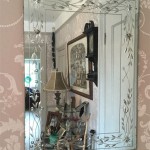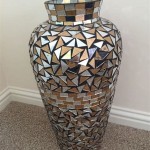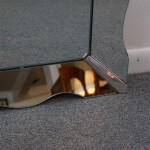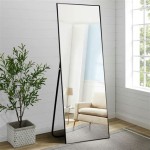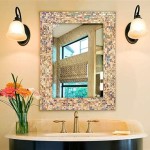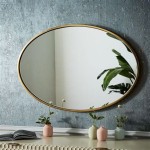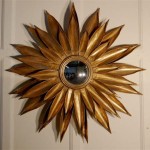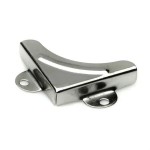Hanging a Large Mirror Over a Sofa
Hanging a large mirror over a sofa is a popular interior design technique used to create a focal point, amplify light, and enhance the sense of space in a room. However, doing so requires careful planning and execution. Choosing the right mirror size and shape, ensuring secure mounting, and achieving proper placement are critical for both aesthetics and safety.
The first step is selecting a mirror that complements the sofa and the overall room decor. The mirror's width should ideally be between two-thirds and three-fourths the width of the sofa. This proportion creates visual balance. Excessively large mirrors can overwhelm the space, while mirrors that are too small can appear insignificant. Consider the sofa's style when choosing a mirror frame. A sleek, modern frame complements a contemporary sofa, while an ornate, vintage frame might suit a more traditional setting.
Mirror shape also plays a significant role in the overall aesthetic. Rectangular and oval mirrors are classic choices that generally work well above sofas. Round or uniquely shaped mirrors can add a touch of personality and visual interest, but careful consideration should be given to ensure the shape harmonizes with the existing décor. The mirror's frame finish should also complement the room's existing color palette and materials.
Before hanging the mirror, careful measurements are crucial. Determine the center point of the sofa and the center point of the wall area above it. These points should align to create a visually balanced arrangement. Ideally, the bottom edge of the mirror should be approximately 6-8 inches above the sofa back. This spacing provides sufficient visual separation between the two pieces and prevents the mirror from appearing too close to the sofa.
Safety is paramount when hanging a large, heavy mirror. Standard picture hangers are typically insufficient for this purpose. Instead, use heavy-duty D-ring hangers or French cleats, which distribute the weight more evenly and provide a more secure hold. Ensure the wall anchors used are appropriate for the wall type and the weight of the mirror. For drywall, toggle bolts or molly bolts are recommended, while masonry walls may require concrete anchors. Consulting the mirror manufacturer’s recommendations for hanging hardware and weight limitations is essential.
The process of hanging the mirror requires precision and typically involves two people. One person holds the mirror in the desired position while the other marks the wall for the hardware placement. Using a level to ensure the mirror hangs straight is crucial for achieving a professional and polished look. Once the hardware is securely installed, carefully lift the mirror into place, ensuring it’s properly engaged with the hanging mechanism.
Lighting plays a significant role in maximizing a mirror's impact. Placing the mirror opposite a window or light source reflects light back into the room, making the space appear brighter and larger. Avoid positioning the mirror where it will reflect direct sunlight, as this can create glare and make the room uncomfortably bright. Consider incorporating wall sconces or other lighting fixtures flanking the mirror to enhance its presence and provide additional illumination.
The surrounding décor should also be considered when hanging a large mirror over a sofa. Avoid overcrowding the wall with other decorative elements. A few carefully chosen pieces, such as artwork or decorative shelves, can complement the mirror without competing for attention. Maintain a sense of balance and visual harmony by ensuring the overall arrangement is pleasing to the eye.
Regular maintenance is essential to keep the mirror looking its best. Dust the frame and mirror surface regularly with a soft, dry cloth. Avoid using abrasive cleaners, which can scratch the mirror or damage the frame. Periodically inspect the hanging hardware to ensure it remains secure and properly attached to the wall. Address any loose screws or other issues promptly to prevent accidents.
Different styles of mirrors can create different effects within the room. For example, a large, ornately framed mirror can add a touch of traditional elegance, while a minimalist, frameless mirror can enhance a modern aesthetic. Similarly, antique mirrors can add character and charm to a space, while contemporary mirrors can create a sleek and sophisticated look. The choice of mirror style should align with the overall design aesthetic of the room.
The positioning of the sofa itself within the room can also affect the impact of the mirror. A sofa placed against a wall benefits from the illusion of increased depth that a well-placed mirror provides. If the sofa is positioned in the center of the room, the mirror can help define the space and create a focal point. Consider the room's layout and furniture arrangement when determining the best placement for both the sofa and the mirror.

In The Mirror Above Couch Decor Home

Wall Art Above Your Couch Unique Ideas From Frame

What To Hang On The Wall Over Your Sofa Closetful Of Clothes

How To Perfectly Style The Blank Wall Behind Your Sofa Zhush

Mirror Over Couch Above Decor

How Hang A Mirror Above Couch In 2024 Over Wall Living Room

Family Room Garland Couch Decor Above Mirror Over

What To Hang On The Wall Over Your Sofa Closetful Of Clothes
:strip_icc()/cdn.cliqueinc.com__cache__posts__189779__large-round-mirrors-189779-1528326128816-main.700x0c-6e62240fb50344ed8626b2537ad786fa.jpg?strip=all)
30 Ways To Style Large Round Mirrors
:strip_icc()/cdn.cliqueinc.com__cache__posts__189779__this-neat-trick-makes-your-room-look-bigger-and-chic-1731602-1460589762.700x0c-16b124fc700a4406a2da75d5f6b6766c.jpg?strip=all)
30 Ways To Style Large Round Mirrors

